Compression plating
1. General considerations
Introduction
Short oblique shaft fractures may be treated with open reduction and compression plate fixation.
The lateral application is preferred as it avoids disturbance of the extensor mechanism insertion.
This fixation follows the principles of compression plating of oblique fractures, ie, the plate should create an axilla (acute angle) with the oblique fracture line.
Depending on the fracture morphology and surgeon’s preference, compression can be applied in one of the following modes:
- Compression with a plate
- Compression with a lag screw through a plate
Intrinsic compression can be achieved with a locking compression plate, shown in this procedure. With an anatomic plate, extrinsic compression is applied with forceps and maintained with locking head screws.
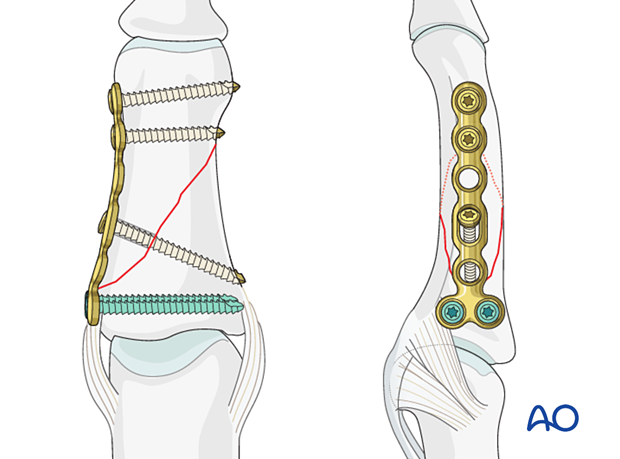
If an axilla for compression plating cannot be created, lag-screw fixation with a neutralization plate should be considered.

Fracture plane
Obliquity of the fracture is possible either in the plane visible in the AP view or the lateral view. Always confirm the fracture configuration with views in both planes.
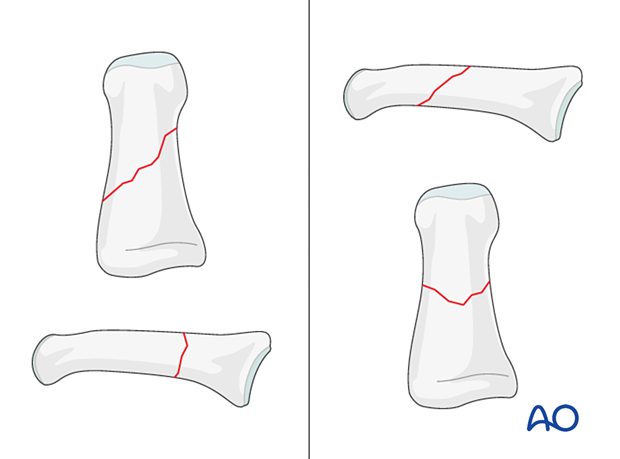
Plate selection
Several plate types (low profile) are available for treatment of this fracture:
- T-plate (adaption plate), dorsal
- Phalangeal base plate, lateral
Select a plate according to fragment size, fracture geometry, and surgeon’s preference.
The plates are available as anatomical plates. The rounded plate edges avoid soft-tissue irritation and adhesion.
If an anatomical plate is not available, a conventional minicondylar plate may be used.
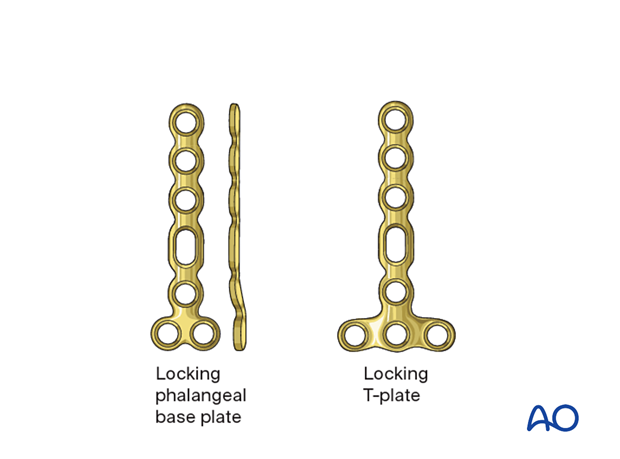
2. Patient preparation
Place the patient supine with the arm on a radiolucent hand table.
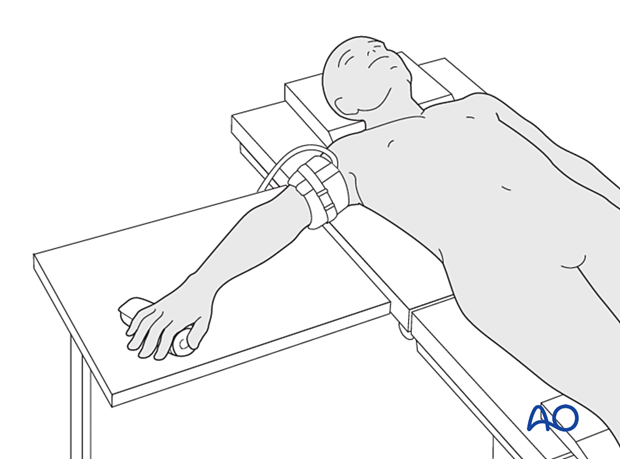
3. Approaches
For this procedure the following approaches may be used:
4. Reduction
Indirect reduction
In many cases, the fracture is not significantly displaced.
Reduction can be achieved by traction and flexion of the proximal interphalangeal (PIP) joint exerted by the surgeon.
Confirm reduction with an image intensifier.
If the fracture appears stable after reduction, nonoperative treatment can be considered. Confirming reduction with an image intensifier is then essential.
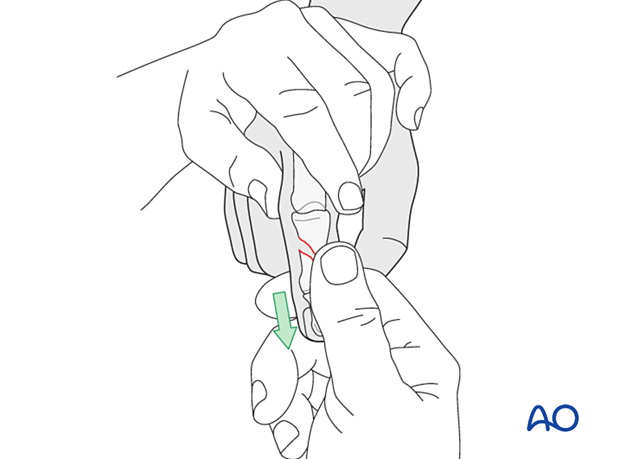
Sometimes indirect reduction may be prevented by interposition of the lateral band.
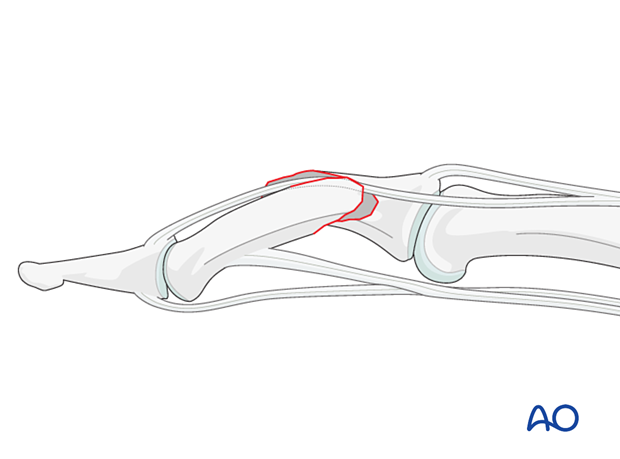
Direct reduction
Direct reduction is necessary when the fracture can not be reduced by traction and flexion, or is unstable.
When indirect reduction is not possible, this is usually due to interposition of parts of the extensor apparatus.
Use pointed reduction forceps for direct reduction.
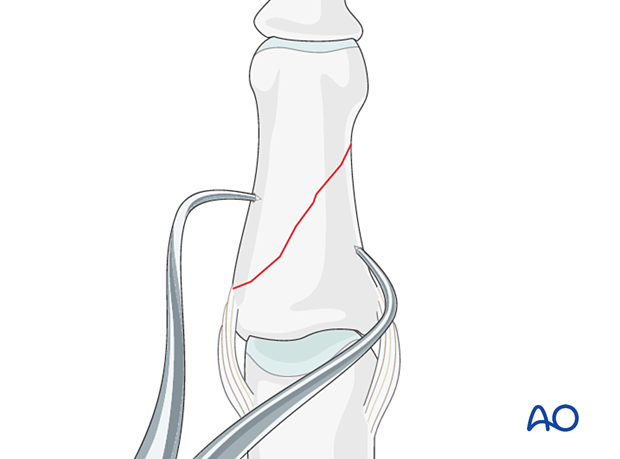
Preliminary fixation
Insert a K-wire for provisional fixation.

5. Checking alignment
Identifying malrotation
At this stage, it is advisable to check the alignment and rotational correction by moving the finger through a range of motion.
Rotational alignment can only be judged with the fingers in a degree of flexion, and never in full extension. Malrotation may manifest itself by overlap of the flexed finger over its neighbor. Subtle rotational malalignments can often be judged by tilting of the leading edge of the fingernail when the fingers are viewed end-on.
If the patient is conscious and the regional anesthesia still allows active movement, the patient can be asked to extend and flex the finger.
Any malrotation is corrected by direct manipulation and later fixed.
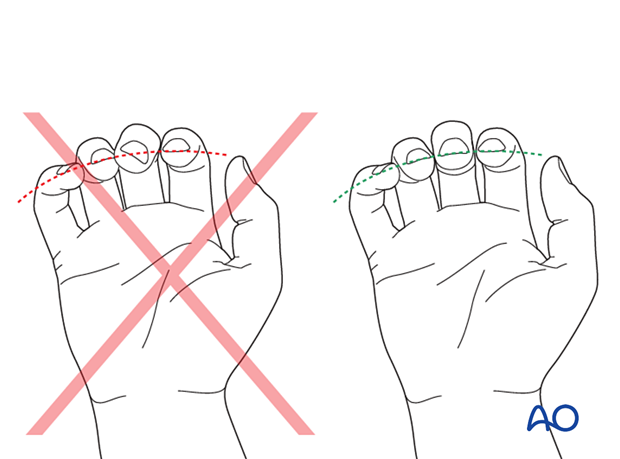
Using the tenodesis effect when under anesthesia
Under general anesthesia, the tenodesis effect is used, with the surgeon fully flexing the wrist to produce extension of the fingers and fully extending the wrist to cause flexion of the fingers.
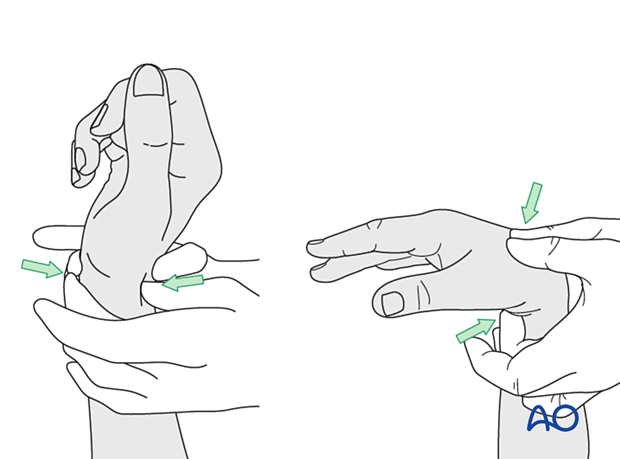
Alternatively, the surgeon can exert pressure against the muscle bellies of the proximal forearm to cause passive flexion of the fingers.
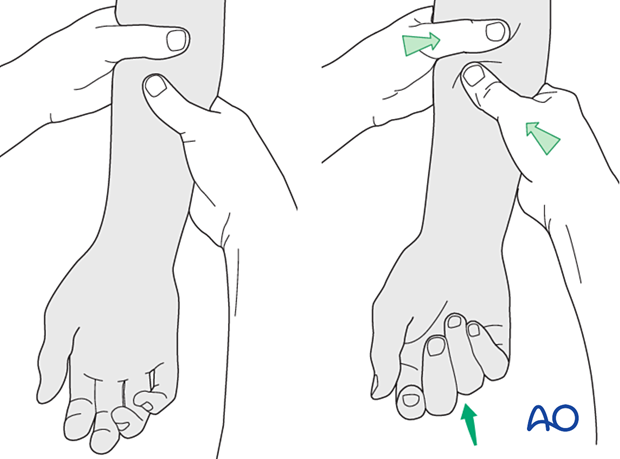
6. Plate fixation
The fixation of an oblique fracture with a dorsal plate follows the principles of compression plating of oblique fractures, ie, the plate should create an axilla with the oblique fracture line.
Plate trimming
Adapt the plate length to fit the length of the middle phalanx. Avoid sharp edges, which may be injurious to the tendons. At least two screws need to be inserted on either side of the fracture zone.
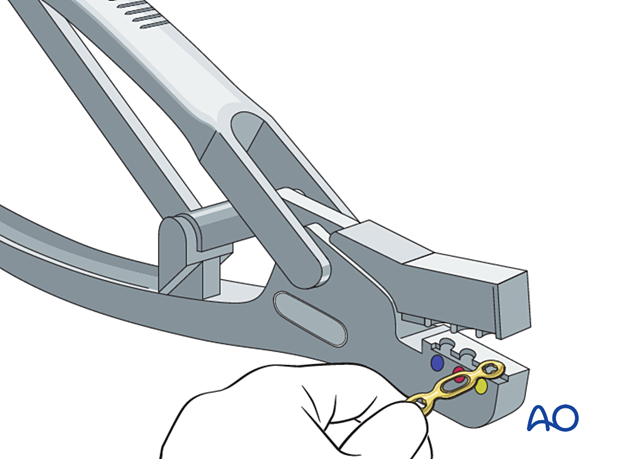
Plate positioning
Place the plate slightly dorsal to the midaxial line of the bone, allowing at least two screws in the proximal fragment.
Keep the plate in place with the atraumatic forceps.
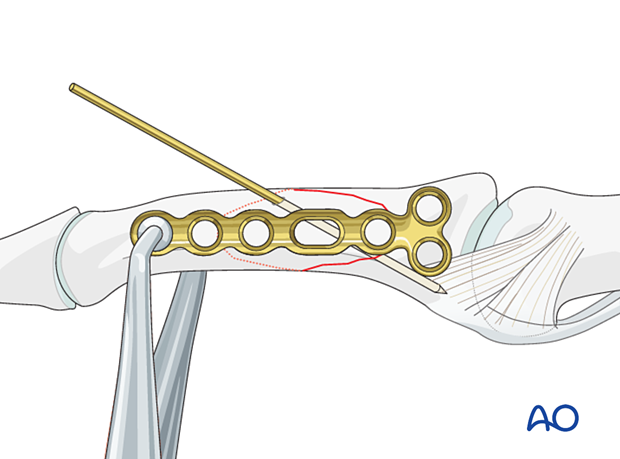
Order of screw insertion
The screws are inserted in an order determined by the direction of the oblique fracture plane.
In our example, we will show an oblique fracture running from radial/proximal to ulnar/distal.
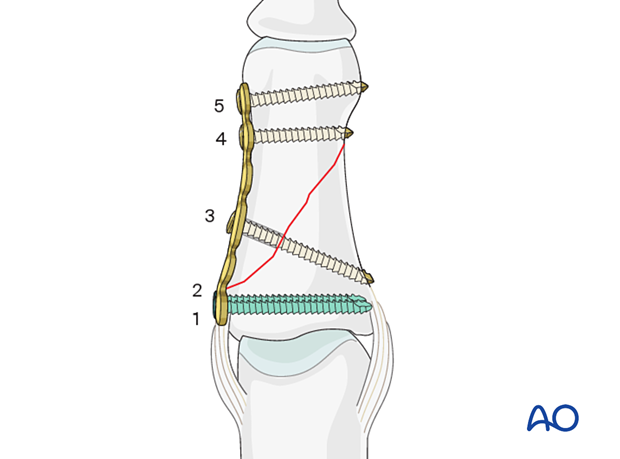
Screw insertion
Insert at least two locking head screws in the articular block.
Before insertion of the second locking head screw, confirm the alignment of the plate with the bone axis.
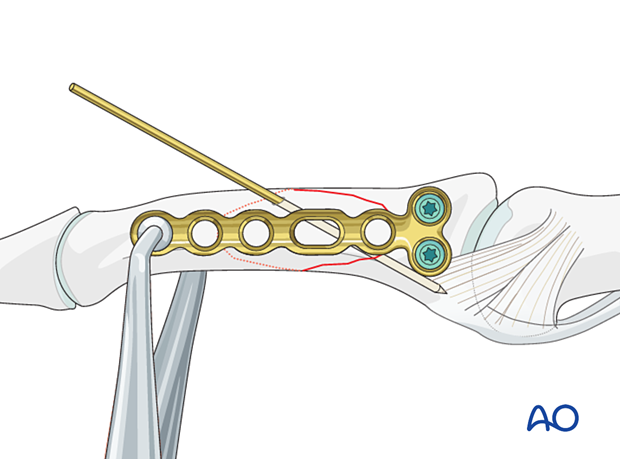
Compression with the plate
Insert the next screw in compression mode in the oblong hole.
Check the plate position with an image intensifier and adjust it if necessary.

Compression with a lag screw
Insert a planned lag screw through the oblong hole as perpendicularly to the fracture line as possible.
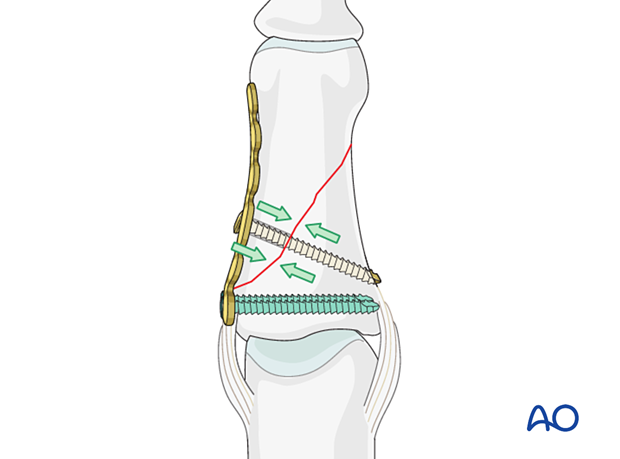
Finalizing plate application
Insert further screws in the shaft and proximal end. In the distal fragment, only cortical screws are needed.
Cover the plate with periosteum to avoid adhesion between the tendon and the implant leading to limited finger movement.
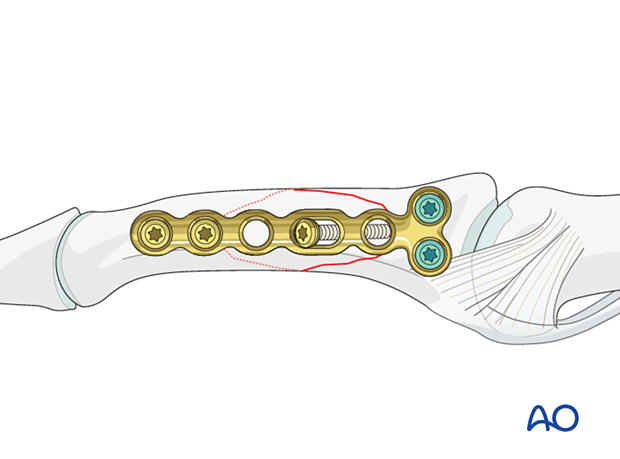
7. Final assessment
Confirm fracture reduction and stability and implant position with an image intensifier.
8. Aftercare
Postoperative phases
The aftercare can be divided into four phases of healing:
- Inflammatory phase (week 1–3)
- Early repair phase (week 4–6)
- Late repair and early tissue remodeling phase (week 7–12)
- Remodeling and reintegration phase (week 13 onwards)
Full details on each phase can be found here.
Postoperative treatment
If there is swelling, the hand is supported with a dorsal splint for a week. This should allow for movement of the unaffected fingers and help with pain and edema control. The arm should be actively elevated to help reduce the swelling.
The hand should be immobilized in an intrinsic plus (Edinburgh) position:
- Neutral wrist position or up to 15° extension
- MCP joint in 90° flexion
- PIP joint in extension
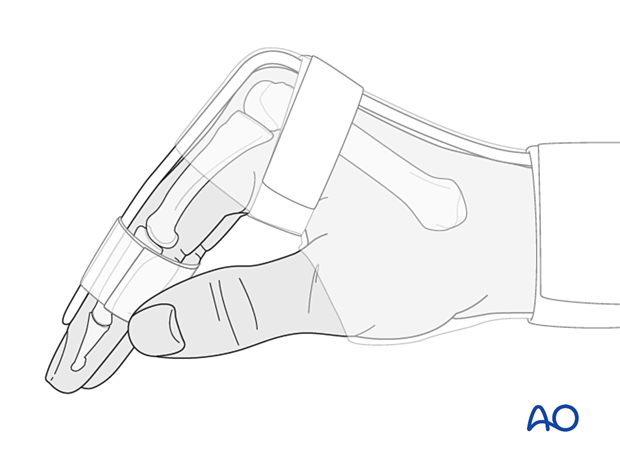
The MCP joint is splinted in flexion to maintain its collateral ligaments at maximal length to avoid contractures.
The PIP joint is splinted in extension to maintain the length of the volar plate.
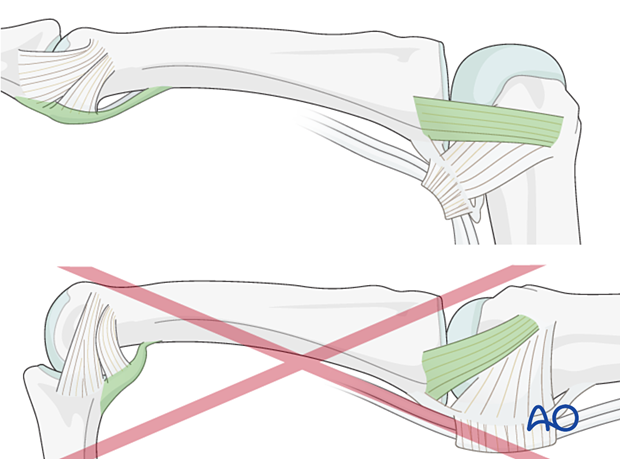
After swelling has subsided, the finger is protected with buddy strapping to neutralize lateral forces on the finger until full fracture consolidation.
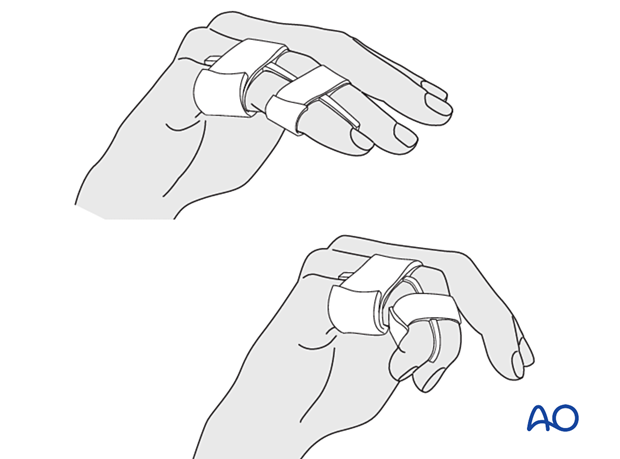
Mobilization
To prevent joint stiffness, the patient should be instructed to begin active motion (flexion and extension) of all nonimmobilized joints immediately after surgery.

Follow-up
The patient is reviewed frequently to ensure progression of hand mobilization.
In the middle phalanx, the fracture line can be visible in the x-ray for up to 6 months. Clinical evaluation (level of pain) is the most important indicator of fracture healing and consolidation.
Implant removal
The implants may need to be removed in cases of soft-tissue irritation.
In case of joint stiffness or tendon adhesion restricting finger movement, arthrolysis or tenolysis may become necessary. In these circumstances, the implants can be removed at the same time.













